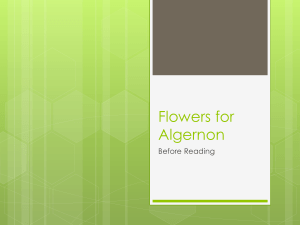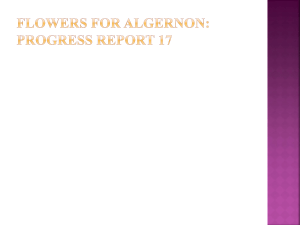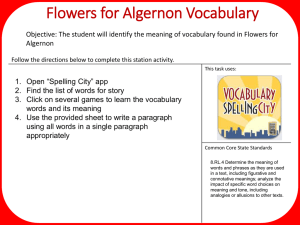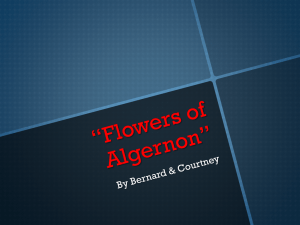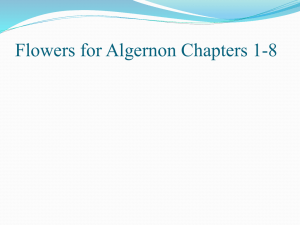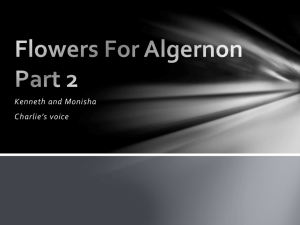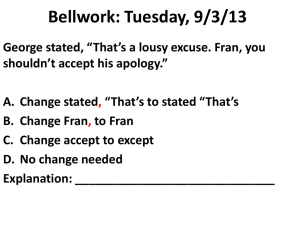“Flowers for Algernon” pp. 190
advertisement
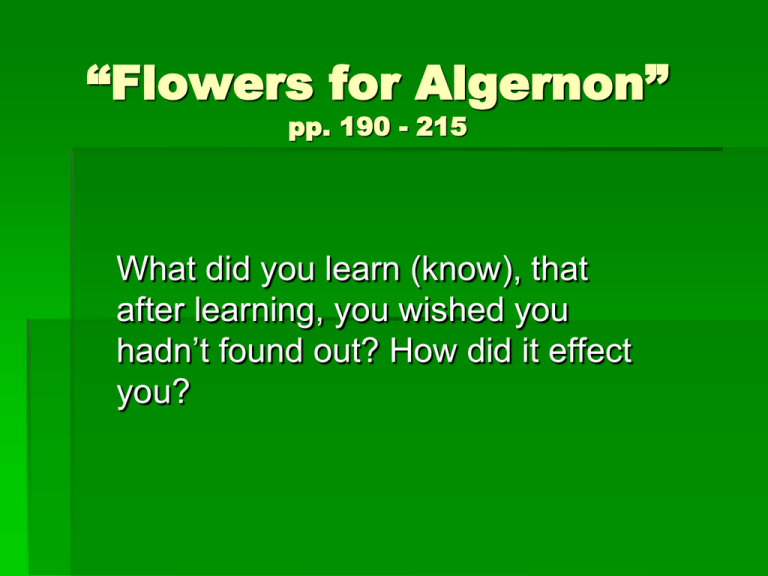
“Flowers for Algernon” pp. 190 - 215 What did you learn (know), that after learning, you wished you hadn’t found out? How did it effect you? “Flowers for Algernon” pp. 190 - 215 Key Terms / Vocabulary character traits Rorschach Test IQ (Intelligence Quotient) first – person POV “Flowers for Algernon” pp. 190 – 215 Vocabulary in Context • Receiving the medal made his success more tangible. • He’s an opportunist because he’ll do anything to get ahead. • The doctor had a specialization in brain development. • The research findings created a sensation at the conference. “Flowers for Algernon” pp. 190 – 215 Vocabulary in Context • Will you refute the results, or do you believe them, too? • His understanding is proportional to his intelligence. • His long work hours could impair his social life. • They laughed at his absurd moves when dancing. “Flowers for Algernon” pp. 190 - 215 Rorschach Test The Rorschach test (also known as the Rorschach inkblot test or simply the Inkblot test) is a psychological test in which subjects' perceptions of inkblots are recorded and then analyzed using psychological interpretation, complex scientifically derived algorithms, or both. Some psychologists use this test to examine a person's personality characteristics and emotional functioning. It has been employed to detect an underlying thought disorder, especially in cases where patients are reluctant to describe their thinking processes openly. The test takes its name from that of its creator, Swiss psychologist Hermann Rorschach. When seeing card I, subjects often inquire on how they should proceed, and questions on what they are allowed to do with the card (e.g. turning it) are not very significant. Being the first card, it can provide clues about how subjects tackle a new and stressful task. It is not, however, a card that is usually difficult for the subject to handle, having readily available popular responses. Card I bat, butterfly, moth Card IV is notable for its dark color and its shading (posing difficulties for depressed subjects), and is generally perceived as a big and sometimes threatening figure; compounded with the common impression of the subject being in an inferior position ("looking up") to it, this serves to elicit a sense of authority. The human or animal content seen in the card is almost invariably classified as male rather than female, and the qualities expressed by the subject may indicate attitudes toward men and authority. Card IV animal hide, skin, rug “Flowers for Algernon” pp. 190 - 215 ► Series of journal entries ► March: 190 – 196 ► April: 197 – 204 ► May: 205 – 210 ► June & July: 210 - 215 “Flowers for Algernon” March pp. 190 – 196 Analyze Visuals: What is the mood of the illustration? Explain how the colors and brush strokes help create that mood. ► (190) ► (190) [A] Character Traits: What can you infer about Charlie’s abilities and personality? “Flowers for Algernon” March pp. 190 – 196 (192) [B] Reading A Long Story: In what way are Charlie’s journal entries unique? ► (192) [C] Character Traits: What d lines 4146 tell you about Charlie’s desire to change? ► (193) [D] POV: Because this story is told in first-person, you learn about Charlie’s thought process directly from him. What do you learn about his mental capacity? ► “Flowers for Algernon” IQ March pp. 190 – 215 IQ Scale Over 140 - Genius or almost genius 120 - 140 - Very superior intelligence 110 - 119 - Superior intelligence 90 - 109 - Average or normal intelligence 80 - 89 - Dullness 70 - 79 - Borderline deficiency in intelligence Under 70 - Feeble-mindedness Normal Distribution of IQ Scores 50% of IQ scores fall between 90 and 110 70% of IQ scores fall between 85 and 115 95% of IQ scores fall between 70 and 130 99.5% of IQ scores fall between 60 and 140 “Flowers for Algernon” IQ March pp. 190 – 215 Low IQ & Mental Retardation An IQ under 70 is considered as "mental retardation" or limited mental ability. 5% of the population falls below 70 on IQ tests. The severity of the mental retardation is commonly broken into 4 levels: 50-70 - Mild mental retardation (85%) 35-50 - Moderate mental retardation (10%) 20-35 - Severe mental retardation (4%) IQ < 20 - Profound mental retardation (1%) High IQ & Genius IQ Genius or near-genius IQ is considered to start around 140 to 145. Less than 1/4 of 1 percent fall into this category. Here are some common designations on the IQ scale: 115-124 - Above average 125-134 - Gifted 135-144 - Very gifted 145-164 - Genius 165-179 - High genius 180-200 - Highest genius “Flowers for Algernon” March ► (193) pp. 190 – 196 [E] Character Traits: What have you learned about Charlie through the comments of Miss Kinnian and the doctors? ► (194) [F] Character Traits: Which of Charlie’s traits convince Dr. Strauss to use him in the experiment? ► (194) [G] Character Traits: What hopes does Charlie have for the operation? “Flowers for Algernon” March ► (195) pp. 190 – 196 analyze Visuals: What is the connection between this illustration and what happens to Charlie? ► (195) [H] Reading A Long Story: In what ways is the March 19 progress report different from the other reports so far (length and language)? ► (196) [I] Character Traits: Why does Charlie think these men are his friends? Note whether he is a good judge of character at this point. “Flowers for Algernon” April ► (197) pp. 197 – 204 [J] POV: How does hearing about the party from Charlie’s POV affect your reaction to his coworkers? ► (198) [K] Reading A Long Story: Note the date on this journal entry. What significant changes have taken place since the first entry one month ago? ► (198) [L] Character Traits: In lines 249-266, what does Charlie’s treatment of Algernon reveal about his character? “Flowers for Algernon” April ► (199) pp. 197 – 204 [M] Character Traits: What can you infer about Miss Kinnian from her conversation with Charlie? ► (201) [N] Character Traits: Why is Charlie ashamed now? Why wasn’t he ashamed a couple of weeks ago? ► (201) [O] POV: How might your understanding of Charlie’s progress be different if you knew what others were thinking? animal: not dog or cat; four-legged animal ► People often express relief about card VIII, which lets them relax and respond effectively. Similar to card V, it represents a "change of pace"; however, the card introduces new elaboration difficulties, being complex and the first multi-colored card in the set. Therefore, people who find processing complex situations or emotional stimuli distressing or difficult may be uncomfortable with this card. “Flowers for Algernon” April ► (202) pp. 197 – 204 [P] Character Traits: How is Charlie’s second experience with the Rorschach test different from his first experience? “Flowers for Algernon” April ► (204) pp. 197 – 204 [Q] Character Traits: What new aspects of Charlie’s personality are revealed in this scene with Miss Kinnian? ► (204) April 30: [1] If you were Charlie, how would you feel after being presented with the petition? “Flowers for Algernon” April ► (204) pp. 197 – 204 April 30: [2] What is the reason workers want Charlie to leave? ► (204) April 30: [3] Who is right about seeking knowledge – Fanny or Charlie? ► (204) April 30: [4] How did Charlie think his life would change once he acquired knowledge? How have his recent experiences proven him wrong? “Flowers for Algernon” April pp. 197 – 204 “When ignorance is bliss, ‘tis folly to be wise.” “Flowers for Algernon” May ► (205) pp. 205 – 210 Analyze Visuals: What might the flask in this illustration symbolize? ► (206) [R] Reading A Long Story]: What do the length and language of the May 15 progress report reveal about Charlie’s intelligence? Think about how this report differs from those in March and April. “Flowers for Algernon” May ► (207) pp. 205-210 [S] Character Traits: How has Charlie’s attitude toward socializing changed? ► (207) [T] Character Traits: Why does Charlie defend the dishwasher? Tell what you can infer about his personality based on his behavior. ► (208) [U] character Traits: How does Charlie’s concern for others affect his goals? ► (209) Analyze Visuals: How does he illustration represent the actions Charlie describes in his May 29 entry? “Flowers for Algernon” May ► May pp. 205-210 23 & 24: (1) What might Algernon’s odd behavior mean for Charlie? ► May 23 & 24: (2) How could Charlie react to this? How does Charlie react to this? ► May 23 & 24: (3) How would you rate Charlie’s chances for success in solving the problem? One feels empathy when one has "been there" and sympathy when one hasn't. Empathy Sympathy ► ► ► ► ► ► The ability to coexperience and relate to the thoughts, emotions, or experience of another without them being communicated directly by the individual Close bonded relationships Friends, Family, Community Caring, Personal Growth Emotional awareness & understanding I can empathize with how aggrieved you must be at the loss of your beloved. The ability to understand and to support the emotional situation or experience of another being with compassion and sensitivity ► Care, Protection ► Poor and less fortunate ► Wisdom, Charity ► Shared sorrow; imaginative identification ► I offer my sympathy at the loss of your loved one. ► “Flowers for Algernon” June – July pp. 210 - 215 •(210) [V] Reading A Long Story: What is different about the June 4 entry? (What do you learn about Charlie and his future from this section? •(211) [W] Reading A Long Story: What does Charlie’s language in the June 10 entry tell about what is happening to his intelligence? (effect toward Algernon’s death) “Flowers for Algernon” June – July pp. 210 - 215 ► (212) [X] POV: What effect does learning about Charlie’s feelings through his own words have on you? ► (213) Analyze Visuals: hat can you infer about what is happening to the man in the picture? ► (214) [Y] Reading A Long Story: Compare July 25 progress report to those from previous months. How does it help you understand what has happened to Charlie? “Flowers for Algernon” June – July pp. 210 - 215 ► (214) [1]: If you were in Charlie’s situation, what do you think would be the hardest part of returning to work at the factory? ► (214) [2]: Why do Frank and Joe defend Charlie? ► (214) [3]: Are the factory workers really Charlie’s friends now? “Flowers for Algernon” June – July pp. 210 - 215 ► (215) [Z] Character Traits: What does Charlie’s attitude toward his experience suggest about the kind of person he is? ► (215) [1]: Do you support Charlie’s decision to leave New York? ► (215) [2]: What does Charlie’s decision reveal about his character? ► (215) [3]: Will Charlie be happier when he leaves New York? Why or why not? “Flowers for Algernon” pp. 190 - 215 ►A narrative arc is the shape a story’s plot takes as it slowly rises, reaches a high point, and then falls to reach a resolution. “Flowers for Algernon” pp. 190 - 215 Bell Shaped Curve “Flowers for Algernon” pp. 190 - 215 Narrative Arc In a successful narrative arc, the hero or heroine is confronted with dangerous threats, seductive choices, major decisions, necessary feats of physical bravery, or emotionally powerful assaults from family or social pressure. “Flowers for Algernon” pp. 190 - 215 PLOT IT
